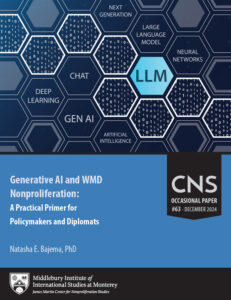December 4, 2024
Natasha E. Bajema, PhD
The rapid advancement of generative AI (e.g., ChatGPT) has opened a Pandora’s box of opportunities and risks for nuclear, biological, and chemical weapons. A new primer from the James Martin Center for Nonproliferation Studies by Dr. Natasha E. Bajema cuts through the hype to explain what policymakers and diplomats really need to know about generative AI to understand its impact on the WMD domain.
While media attention has focused on ChatGPT and other generative AI models potentially helping bad actors develop weapons, the reality for the WMD domain is more nuanced. Predictive AI tools are already being deployed in military applications. These narrow, task-specific systems can analyze data patterns to support decision-making, but also introduce new risks through cyber vulnerabilities and data biases. Meanwhile, current generative AI models still struggle with accuracy and reliability—they are prone to making up false information and are not yet capable of transferring the tacit knowledge needed for weapons development. However, this could change as the technology advances.
The primer highlights several key challenges:
- Data quality issues: AI systems are only as good as their training data, which is often biased or incomplete for national security applications
- Cyber vulnerabilities: AI systems can be hacked or manipulated in ways that could compromise WMD nonproliferation-related activities
- Lack of transparency: The “black box” nature of AI makes it difficult to understand how systems reach their conclusions
- Regulatory gaps: Current frameworks struggle to address AI’s unique characteristics
But there are also opportunities. AI could enhance verification of arms control agreements, improve early warning systems, and help detect proliferation activities. However, organizations leveraging generative AI for WMD nonproliferation still need to be wary of the technology’s current flaws and limitations. The key is developing appropriate safety norms and governance frameworks.
As the primer argues, policymakers need to act now to shape AI’s trajectory in the WMD space. This requires:
- Establishing benchmarks to measure AI capabilities in the WMD domain
- Conducting regular safety evaluations on WMD issues
- Building human oversight into AI systems and creating international norms
- Strengthening international cooperation on AI governance
The window for steering these powerful technologies toward positive outcomes in the WMD domain may be closing. This primer provides essential guidance for those working to ensure AI supports rather than undermines WMD nonproliferation goals.
Want to learn more? Read the full primer here:

